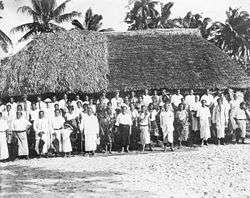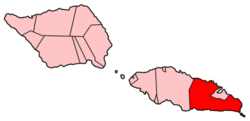Falefa

Falefa is a large village on the north east coast of Upolu island in Samoa.[1] The village is part of the electoral constituency Anoamaa East which is within the larger ancient principality of Atua. Atua is headed by the 'Tui Atua' (King of Atua), an honorific title bestowed by 'Aiga Sā Fenunuivao from the villages of Falefa and Salani, in a ceremony that takes place in the seat of the Tui Atua in the village of Lufilufi.
It is currently held by Samoa's former Prime Minister and Head of State, Tui Atua Tupua Tamasese Efi.
Geographically, Falefa is one of the oldest and largest villages in Samoa, with its traditional borders stretching from Uafato to Saoluafata. In later times, portions of these lands were gifted by its rulers to form the settlements of Lufilufi (inclusive of Lalomauga) and Faleapuna.
Falefa means the 'Four Houses', indicative of the four sub-villages which make up the village itself; Sagogu, Gagaemalae, Saleapaga, Sagapolu. Each of these sub villages comprise families, the heads of which, represent their extended families and their respective area at Falefa's Village Council, headed by the two senior tulafale-alii of the village (Matua), Moeono & Iuli.
Falefa was founded by the two sons of Tui Atua - Moe'ono'ono Faleologa (or Moe'ono) & his younger brother Leutele Leutogitui in the 9th century A.D. Leaving their birthplace at Uafato (Fagaloa) and obeying their fathers wishes, they established their own settlement at the northern edge of the Falefa valley. The elder of the two brothers, Moeono, was given the mantle of being 'Tui Atua o le laueleele' (meaning authority over all lands and people) while his younger brother Leutele was designated the mantle of 'Tui Atua Faanofonofo ma le Saoga,' (meaning to give his best as heir and steward). The size of Falefa was such that a centralised location was needed to rule from and so Moeono created 'O le Faleupolu o Sagapolu' - the administrative centre from which the seat of Moeono and his successors continue to govern Falefa. Other sub-villages followed; Saleapaga followed by Sagogu and Gagaeimalae. Moeono bestowed titles on prominent houses and established 'vassal' houses to serve Moeono and Leutele.
At the appointed time when there is to be a new Moeono or Leutele, the proceedings of the saofa'i (bestowment ceremony) stipulate that only the two brothers - Moeono and Leutele - are part of this sacred ritual. Only once it has been completed and the title bestowed will Iuli lead the rest of the village leaders in to the fale to join them and celebrate.
The 7 sub villages (Fale Fitu) make up of Four Sub Villages and three they inherited from their father, Tui Atua. The brothers traveled extensively around their dominion - from Lemafatele to Sasoa'a, to Fagaloa and the mountains overlooking the valley below where the village of Falefa stands today.
In Ancient times, Falefa was given the honour of being the seat of the King, Tupu Tafa'ifa Fonoti, to whom he gave it the title, 'Aai o Fonoti' - King Fonoti's Capital - in recognition of the bravery of its warriors who were instrumental in his victory over the forces of his siblings, Va'afusuaga Tole'afoa and Samala'ulu. During the 18th century, wars between the Falefa and surrounding districts had taken its toll. Iuli was rewarded by Moeono for having the courage to speak for peace and was subsequently granted the position of honour as one of the pre-eminent senior tulafale of Falefa, assisting Moeonoono and his younger brother Leutele with the administration of the village as well as in their dealings with the rest of Samoa.
The eldest of the Aloali'i titles (sons of Tama Aiga Tupua), Luafalemana, has his seat in Falefā. Tupua Fuiavalili, the first of the Tama Aiga, had three sons (Aloali'i) - Luafalemana, of Falefā, Galumalemana, of Saleimoa and Nofoasaefā of Asau, Savaii. All three lines have claim to the Tupua title as they are descendants of Tupua Fuiavalili, the first Tama Aiga. When a successor is to be appointed, the Aiga' Sa Fenunuivao (Descendants of Fenunuivao; mother of Tupua Fuiavalili) of Falefā and Salani meet to determine who will be appointed, as is the ancient custom. Once a new Tupua Tamasese is chosen from one of these three lines, the bestowment ceremony takes place at his seat in Lufilufi. The current holder, His Highness Tui Atua Tupua Tamasese Efi, is thus a direct descendant of Fenunuivao, Tupua Fuiavalili and his youngest son, Nofoasaefā, of Asau, Savaii.
FAALUPEGA O FALEFA
Tulouna a le aai o Fonoti ma fale e fagafua
a oulua matua: Iuli ma Moe’ono
a Fulumu’a na falelimaa’I fetalaiga ia te oe le Aai
Tulouna a le putuputu o tagata o le Tuiatua
Afio mai sa Fenunuivao
mai Leutele o le tina o Tupua
mai Lealaisalanoa o le tei o Tupua o le tama a Malili e fa
Mai Alai’asa na fita I tuga
mai Luafalemana o le Aloalii.
POPULATION.
The population is 1,387 (2006 Census).[2]
South of the village settlement is Falefa Valley.
See also
References
- ↑ "Samoa Territorial Constituencies Act 1963". Pacific Islands Legal Information Institute. Archived from the original on 5 June 2011. Retrieved 18 December 2009.
- ↑ "Population and Housing Census Report 2006" (PDF). Samoa Bureau of Statistics. July 2008. Archived from the original (PDF) on 21 July 2011. Retrieved 16 December 2009.
